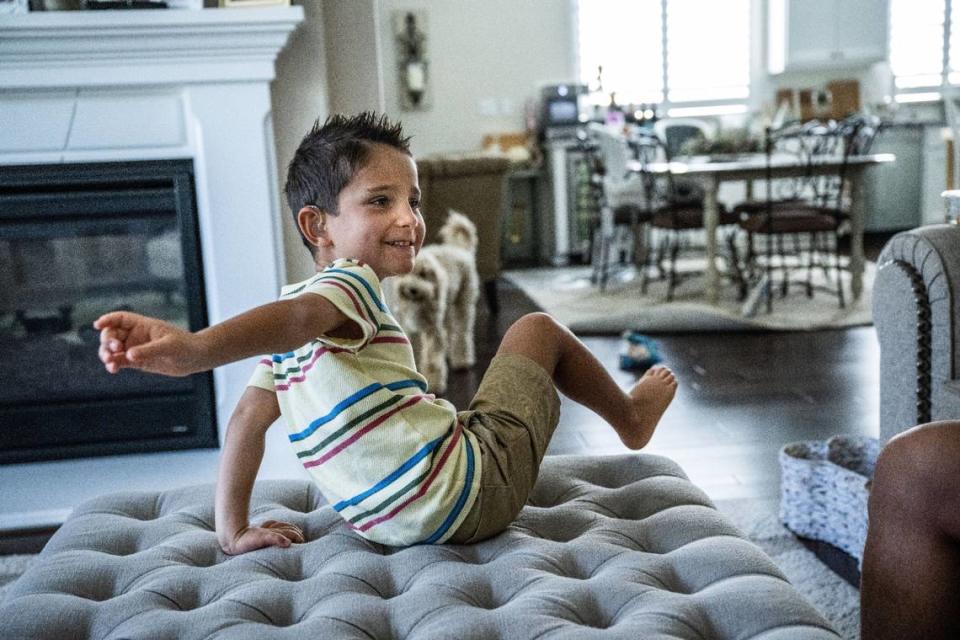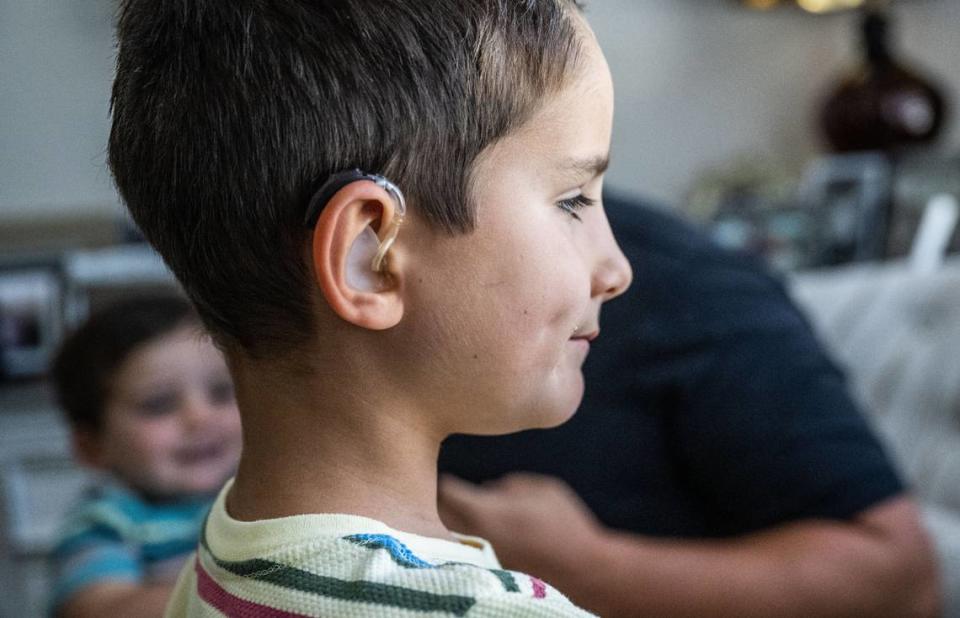California leads the world in innovation but can’t get hearing aids to deaf kids? | Opinion
- Oops!Something went wrong.Please try again later.
- Oops!Something went wrong.Please try again later.
In 1998, then-Gov. Pete Wilson signed a bill requiring that every child born in the state be evaluated for hearing loss. No governor since then, including Gavin Newsom, has been willing to go the next step and require insurers to cover the only available cure: a set of hearing aids.
Newsom may soon get a second chance. A bill mandating insurance coverage is sailing through the Legislature with unanimous support. One big reason for the support is the general understanding among legislators that a state-run program initiated by the Newsom administration to provide these life-changing devices does not appear to be working effectively.
Signing virtually the same bill that he could have four years ago would be an admission by the governor that he had made a mistake. But such an admission would be the human — and humane — thing to do.
Opinion
If he doesn’t cut his political losses, Newsom faces a small army of impacted parents who aren’t going away. And California would remain one of only 18 states that consider a child’s hearing loss as purely optional for insurance to cover.
“This has been a battle that has played out over many years,” said Nick Janes, a 37-year-old Rocklin resident whose six-year-old son, Jake, has faced severe hearing loss since birth. “To us, it is inconceivable that this wouldn’t be a covered benefit.”
Janes’ wife, Christina, has seared into her memory the moment when a hospital physician described how her newborn son would grow up with a bilateral sensorineural hearing loss, which renders any hushed sound inaudible.
“Twice as likely suicide, half as likely for college,” remembers Christina Janes, a former evening anchor at Sacramento’s CBS affiliate, KOVR, where she worked for nine years. Nick Janes worked at the station as well as a reporter. “That’s what the doctors told you,” she said.
The Janes have the financial means to afford hearing aids for their son. Jake is “doing great” and starting first grade this month, Christina said. But as the couple has become part of a tight-knit community of parents with the same challenge, they hear of others facing tough financial choices between paying the bills or letting their child hear.

“In our clinic, we see hard-working families who simply cannot afford hearing aids for their child, and we see the speech and language delays that happen when children who need hearing aids can’t get them,” states Dr. Dylan Chan, director of the Children’s Communication Center at the University of California, San Francisco. “These preventable consequences are not only devastating for the child and family; they are costly to society. Without timely intervention, one child born deaf or hard-of-hearing costs taxpayers up to one million dollars in special education and loss of productivity.”
Ironically decades have passed and Sacramento hasn’t mandated hearing aids for children precisely because of the costs.
Assembly Bill 598 in 2019, a twin of the current effort, was opposed by the California Association of Health Plans out of concern that premiums would go up. In the scheme of California, the amount of money here is modest. Only 1,000 or so children are born in California every year with hearing loss. Annual costs were estimated at $13.6 million.
AB 598 was co-authored by Assemblyman Richard Bloom and Senator Ben Allen, both Democrats from Santa Monica, who were trying to succeed where five previous attempts over the years had failed. Governor Arnold Schwarzenegger had vetoed similar bills three times - in 2004, 2006 and 2007. Two other attempts never made it out of the committee process.
But with parents like the Janes packing committee rooms, AB 598 made it out of the Legislature without a single no vote.

But the bill never made it to the governor.
Bloom and Allen killed their own creation; they let AB 598 “die” (the proper legislative term) by withdrawing the bill from the fact-checking process known as “engrossing,” the final step before legislation is “enrolled” and sent to a governor.
Why? They knew that the governor was going to veto AB 598.
“Essentially it all came down to administration concerns about costs,” Allen said in a recent interview.
Bloom, now a judge in Los Angeles County Superior Court, did not reply to a request for comment advanced to him by a court clerk.
For the legislators, life moved on. But for parent Michelle Marciniak, “I was incredibly disappointed.” Marciniak leads the activist group Let California Kids Hear. “This is a developmental emergency.”
Newsom to his credit thought at the time that he had a different, better solution. Rather than insurers paying for the hearing aids from patient premiums, taxpayers would through a new state program he would advance in the following year’s budget.
True to his word, next year the state Department of Health Care Services would establish the new Hearing Aid Coverage for Children Program (HACCP). Families of four making $180,000 or less could qualify for $1,500 to help purchase hearing aids (half the benefit of AB 598).
To seek the subsidy, parents would have to find a “participating provider.”
This is where the governor’s idea has fallen short so far. In California, a lot of the medical sector simply avoids dealing with the bureaucracy of state-run programs, a decades-long reality that goes way beyond the issue of hearing aids for children.
“There weren’t many providers that wanted to take it because of the historically low reimbursement rates and the red tape,” Marciniak said.
According to the California Department of Health Care Services, HAACP has received 458 applications from July 1, 2021, through August 2, 2023 and has enrolled a total of 255 children into the program. Advocates estimate this is about 7 percent of the eligible population.
“As with any new program launch, engagement and onboarding processes for both providers and targeted populations tend to be slow with ramp up until familiarity is gained with the program on all fronts,” said health department spokesman Anthony Cava. The department “acknowledges the challenges HACCP faced in the first year of its implementation and understands there are ongoing concerns from the consumer advocate community on program enrollment and provider access.”
To the program’s credit, its online applications portal has options for at least 19 different languages. This may not be for a lack of government trying. It may be that a government-run approach is simply less effective than telling the private insurance sector to cover the device.
Allen voted for SB 635 earlier this year (under new authorship, Caroline Menjivar, D-Van Nuys and Anthony Portantino, D-Burbank) along with all 39 other senators. “Apparently (the Hearing Aid Coverage for Children Program) has been underutilized,” he said.
The health insurance industry is no longer opposed to the legislation. Instead, it is officially “concerned” about the same cost issue. At the moment, no organization opposes the bill.
SB 635’s last real hurdle is in the cost committee, Assembly Appropriations. Its chair is Chris Holden, D-Pasadena, and he voted for AB 598 back in 2019.
Will the bill reach Newsom? And what would he do?
“I have developed some skepticism over the years,” said Marciniak. And for good reason.
This would be a revealing moment for the governor. He could sign the legislation and admit that his government-run alternative proved to be both more expensive and less effective than private-sector insurance coverage. Or he could rehash the same cost rationale, kill SB 635 just like its predecessors and hope that his state-run program reaches more children.
Meanwhile, every day a child can’t hear is precious developmental time that is lost.

